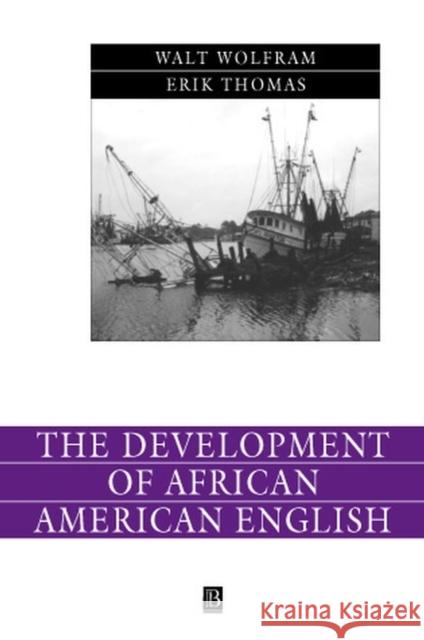The Development of African American English » książka



The Development of African American English
ISBN-13: 9780631230878 / Angielski / Miękka / 2002 / 256 str.
The Development of African American English
ISBN-13: 9780631230878 / Angielski / Miękka / 2002 / 256 str.
(netto: 281,64 VAT: 5%)
Najniższa cena z 30 dni: 294,50
ok. 30 dni roboczych
Bez gwarancji dostawy przed świętami
Darmowa dostawa!
This book focuses on one of the most persistent and controversial questions in modern sociolinguistics: the past and present development of African American Vernacular English (AAVE).
"The Development of African American English is a masterpiece. The authors systematically examine linguistic and historical evidence from an area (Hyde County, North Carolina ) that has not figured in earlier discussions of African American Vernacular English . The result is a more complex and intricate picture of Black/White sociolinguistic relations,both now and in the past, than we have had to this point, with rich implications for how research on language variation and change should be conducted more generally." John R. Rickford, Stanford University
"Wolfram and Thomas′s investigation of language in a biracial Southern enclave has much to tell us. Their attention to key issues of theory and methodology informs their research and bolsters a set of carefully argued conclusions about the history of African American English. The authors′ work takes on a broader significance by their willingness to tackle vexing questions, whether the issue is how to assess differences in intonation patterns between African Americans and European Americans or how to relate individual differences to community variation." John Singler, New York University
"Specialized but of the utmost importance to dialectologists and sociologists, this volume is exhaustive, accurate, provocative, and compelling. Recommended enthusiastically for graduate students, researchers, and faculty." Choice, December 2002, Vol 40 No. 04
Series Editor′s Preface.
List of Figures.
List of Tables.
Preface.
1. Introduction:.
The Status of African American English.
A Unique Data Base.
The Hyde County Corpus.
Data Analysis.
Beyond Hyde County.
2. Issue in the Development of African American English:.
Hypotheses on Earlier African American English.
Issues in Reconstructing Earlier AAVE.
The Nature of Earlier Written Texts.
Spoken Language Data Representing Earlier AAVE.
The Sociohistorical Context of Earlier African Americans.
Variation in Earlier AAVE.
Donor Source Attribution.
African American English in the Twentieth Century.
3. Defining the Enclave Dialect Community:.
Introduction.
Historically Isolated Speech Communities.
Geography.
Economy.
Historical Continuity.
Social Relations.
Group Identity.
The Social Construction of Enclave Status.
Language Change in Enclave Communities.
Sociolinguistic Principles in the Configuration of Isolated Dialects.
4. The Social History of Mainland Hyde County: .
Chesapeake Bay Origins.
The Settlement of Hyde County.
Hyde County from the Revolutionary War to the Civil War.
Reconstruction to the Great Depression.
Hyde County since 1940.
Sociohistorical Effects on Language.
5. Morphosyntactic Alignment in Hyde County English: .
Issues in Attribution.
Past Tense be Regularization.
The Historical Development of Leveling to Weren′t.
Was/Weren′t Leveling in Hyde County.
Copula/Auxiliary Is and Are Absence.
The Historical Development of Copula Absence. |.
Copula Absence in Hyde County.
Third Person –S Marking.
The Historical Development of Verbal –S Marking.
Verbal –S Marking in Hyde County.
Conclusion.
6. Vocalic Alignment in Hyde County:.
An Overview of Hyde County Vowels.
The Historical Background of Hyde County Vowels.
Quantitative Analysis of Hyde County Vowels.
Conclusions.
7. Consonantal Alignment in Hyde County: .
Earlier Hyde County Consonants.
The Case of Consonant Cluster Reduction.
The Patterning of Cluster Reduction.
The Case of Postvocalic r Vocalization.
The Patterning of Postvocalic r–lessness.
Post–/?/ r Vocalization.
Conclusion.
8. Intonational Alignment in Hyde County English: .
African American and European American Intonation.
Analytical Methods.
Results and Implications.
Conclusions.
9. The Individual and Group in Earlier African American English: .
The Individual and Group in Variation Studies.
The Sample of Elderly African American Speakers.
Some Diagnostic Variables.
Rhoticity.
Syllable–Coda Consonant Cluster Reduction.
The Vowel System.
Verbal –s Concord.
Copula Absence.
Past Tense be Leveling.
Patterns of Correlation and Individuation.
Variation in Earlier AAVE.
10. Beyond Hyde County: Te Past and Present Development of AAVE: .
The Origin of African American English.
The Regional Context of Earlier African American English.
Levels of Linguistic Alignment.
The Trajectory of Language Change.
The Norming of AAVE.
Issues in Vernacular Dialect Norming.
Vernacular Language Norming in Hyde County.
Explaining the Supraregional Norms of Contemporary AAVE.
Conclusion.
References.
Index.
Walt Wolfram is William C. Friday Distinguished Professor at North Carolina State University. He has pioneered research on a wide range of American vernacular dialects and authored or co–authored 15 books, including American English (Blackwell 1998, with Natalie Schilling–Estes) and over 200 articles.
Erik R. Thomas is Associate Professor of Linguistics at North Carolina State University. He is author of An Acoustic Analysis of Vowel Variation in New World English (2001), and has published widely in journals such as Language Variation and Change, Journal of Pidgin and Creole Languages, and Journal of Phonetics.
This book focuses on one of the most persistent and controversial questions in modern sociolinguistics: the past and present development of African American Vernacular English (AAVE).
Despite intense scrutiny of the historical and current development of AAVE, a number of issues remain unresolved. Most prominent among these is the development of African American English during the antebellum period and the trajectory of change in twentieth–century AAVE. This book addresses both of these issues by examining an unparalleled sociolinguistic situation involving a long–standing, isolated, biracial community situated in a distinctive dialect region of coastal North Carolina. This unique environment provides a venue for dealing with questions of localized dialect accommodation and ethnolinguistic distinctiveness in earlier African American English.
The conclusions drawn challenge the Creolist, Anglicist, and neo–Anglicist positions with respect to the history of AAVE and offer insights into the development of African American speech in the twentieth century.
1997-2025 DolnySlask.com Agencja Internetowa
KrainaKsiazek.PL - Księgarnia Internetowa









